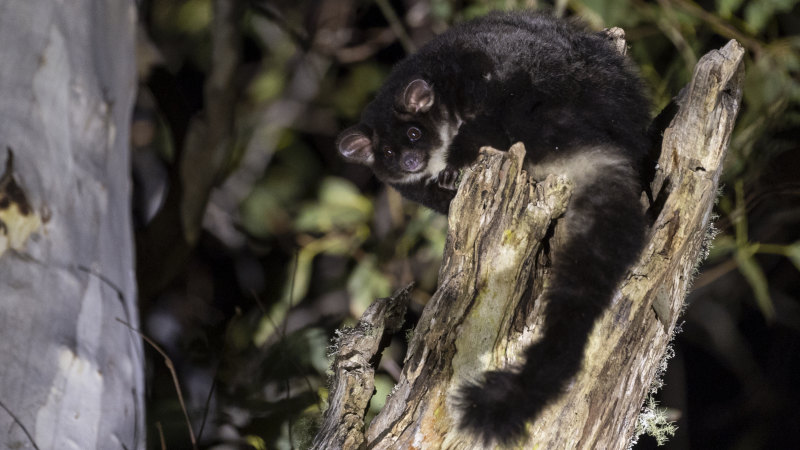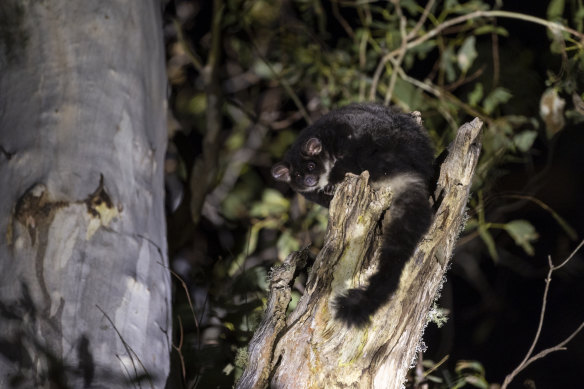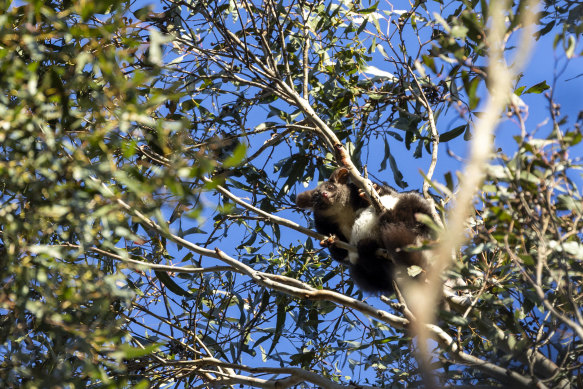By Mike Foley
Save articles for later
Add articles to your saved list and come back to them any time.
It’s 10 minutes after sunset in a misty forest in south-eastern Australia and one of the most threatened mammals in the world is peering down from its perch in a centuries-old gum tree at the gaggle of people below.
Greater gliders – the world’s largest gliding marsupial – are the flying koalas that most people haven’t heard of and fewer have seen.
The fluffy forest dweller with satellite-dish ears can glide through the air for up to 100 metres, zooming from tree to tree in a furry wingsuit that stretches between its front and back legs.
A greater glider emerges from its ancient tree hollow to prepare for dinner in Tallaganda National Park.Credit: Alex Ellinghausen.
Nature’s unlikely design for greater gliders could have been lifted from a children’s book, but unfortunately for animal lovers, they’re much harder to spot than koalas.
They come with all manner of markings – their fur coats range from all-black to all-white and everything in between. Gliders weigh up to 1.6 kilograms, less than half the weight of a small female koala, and live their entire lives high in the canopy, hidden in their homes until dark.
That’s why a photographer, two scientists and a reporter stood shivering on a cold November night beneath a tree in Tallaganda National Park, east of Canberra, staring up into the darkness in the hope of catching a glimpse of the elusive marsupial.
It was the same tree where, two days earlier, conservation biologist Ana Gracanin spotted a greater glider slipping inside the stump of a fallen branch 20 metres up.
“These old trees form hollows and inside is where we find greater gliders and dozens of other marsupial species,” says Gracanin, a post-doctoral research fellow at the Australian National University.
“They generally try to avoid gliding. They move through the canopy with their amazing paws that allow them to go on branches that are only 5 millimetres thick to climb through the canopy.
“When there is no canopy for them, or they are spooked by a predator, they will launch off the tree and glide.”
Through the gloom, a little blaze of white appears within a jet-black hole in the tree branch and, moments later, torches click on to reveal a greater glider emerging from the tree hollow.
This glider looks like it barely registers the intruders below. A side effect of its diet of eucalyptus leaves, which are low in nutrition and high in toxins, is a slow metabolism and dozy disposition – much like koalas.
Tallaganda National Park is one of the last remaining strongholds for gliders, which were once common in forests from the tip of Cape York down the eastern seaboard into Central Victoria.
But greater gliders – scientific name petauroides volans – are now so rare that the species was last year listed as endangered – a classification the federal government gives to animals at imminent risk of extinction in the wild.
ANU ecologist Dr Kara Youngentob has spent two decades studying gliders, which she says are now “functionally extinct” in many locations, meaning the population is not robust enough to sustain itself into the future.
“They’ve gone extinct from regions where there used to be lots of them,” Youngentob says.
The species’ overall population has fallen 80 per cent in the past two decades.
“When I first started working with gliders 20 years ago, they were very common. They were on a decline, but they weren’t hard to find. But now, places that I work, there are no gliders there any more,” Youngentob says.
When top forest predator the powerful owl takes up a roost in a new patch of forest, it kills all the gliders in surrounding trees before moving on to a new feeding ground. But experts say logging is the biggest threat to the survival of the species, followed by habitat loss due to urban development and global warming.
Global warming is making the weather hotter more frequently, which is more bad news for gliders. Hotter, drier weather is spurring bigger, hotter bushfires that destroy gliders’ habitat. It’s also putting them off their dinner.
“These guys get all their water from their food, and they lose their appetite when they get too hot. It doesn’t take long for them to die outright,” Youngentob says.
Senior research fellow at ANU, Dr Kara Youngentob, at Tallaganda National Park.Credit: Alex Ellinghausen.
Next door to Tallaganda National Park, in which timber harvesting is banned, Tallaganda State Forest is an active logging area.
NSW’s Environment Protection Authority earlier this year shut down logging in the state forest after it ruled state forestry workers had failed to set up the required 50-metre exclusion zones around trees where gliders were living.
Conservation groups have criticised NSW Forestry Corporation for searching for gliders only during the day when they are almost impossible to find, while the logging corporation argues there is no requirement to search for them at night.
A NSW Forestry Corp survey of an area in Tallaganda in October identified just one tree where gliders had made a den. But the EPA issued a stop-work order after it identified 20 habitat trees.
While the Commonwealth has sweeping powers to protect native species, the Albanese government is already a year overdue on its promise to reform national environment laws under the Environment Protection and Biodiversity Conservation Act.
Experts warn far greater protections are urgently needed because current safeguards are failing to slow the pace of native wildlife losses.
Gracanin collects health data from a female glider that was carrying a baby.Credit: Alex Ellinghausen
Australia is a global hotspot for wildlife extinctions. Since colonisation, Australia has lost 34 mammals, which is about the same number as the rest of the world combined over the past 200 years.
Federal Environment Minister Tanya Plibersek has pledged to lodge her reforms in parliament sometime next year, promising to rectify one of the most controversial aspects of the current laws – regional forestry agreements.
These agreements, struck between federal and state governments, in effect exempt native forest logging from national environment laws, including threatened species protections.
“Our government has already announced that for the first time in Australian history, regional forest agreements will have to comply with national environmental law,” Plibersek says.
Professor David Lindenmayer, an eminent conservation scientist and Biodiversity Council member, is working in Booderee National Park, in Jervis Bay on NSW’s South Coast, in a bid to reintroduce gliders there.
They disappeared from the largely untouched landscape in 2007, a troubling development that he puts down to a combination of factors.
A southern greater glider at Tallaganda National Park.Credit: Alex Ellinghausen
“It’s hard to find the cause other than it was around about that time that there was a lot of urban development at the base of the peninsula, which is Jervis Bay. Then we had big fires in 2003 and we’ve had a series of very, very, very hot summers with very high overnight temperatures,” Lindenmayer says.
Youngentob and Lindenmayer are focused on finding the best micro-climates in the park, with cooler conditions, that may offer the best chance to any reintroduced gliders.
“We’re going to give it the best shot that we can with the best possible science,” Lindenmayer says.
A spokesperson for Forestry Corp says it believes it has been complying with regulations and implementing the same regime for the past five years. The corporation is seeking clarification from the EPA about its stop-work order.
Cut through the noise of federal politics with news, views and expert analysis. Subscribers can sign up to our weekly Inside Politics newsletter.
Most Viewed in Politics
Source: Read Full Article







